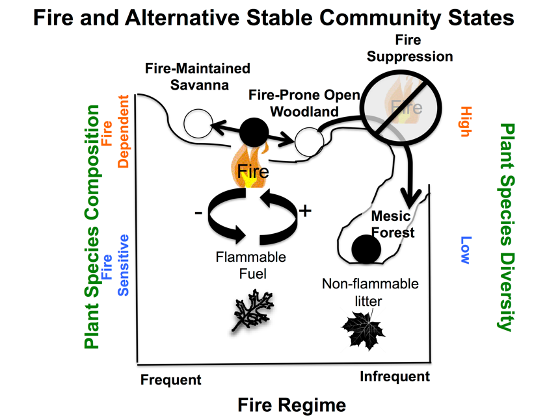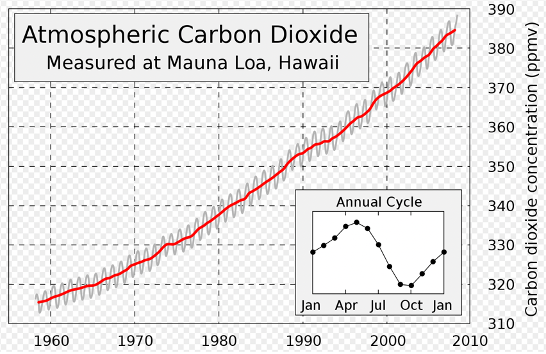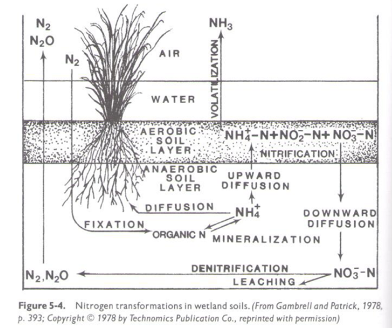bisc 322 - brewer - final exam
1/47
There's no tags or description
Looks like no tags are added yet.
Name | Mastery | Learn | Test | Matching | Spaced |
|---|
No study sessions yet.
48 Terms
What is a community?
An assemblage of two or more species in a given area. These species often interact in some way. As a result, community ecologists are typically interested in one or more of these types of species interactions.
What are the four key properties of communities?
a. Diversity: richness and evenness
b. Structure: dominant vegetation type
c. Stability: the ability of a community to maintain (resistance) or return (resilience) to its original species composition after a perturbation (disturbance)
d. Trophic structure: feeding relationships among species
i. Determines the pattern of energy flow and nutrient cycling in a community
What are the differences between the two components of diversity: richness and evenness?
a. Richness: the number of species in a given area
b. Evenness: equability of abundance
What are the rank-abundance curves?
They show richness and evenness of a community
What is the competitive exclusion principle?
a. No two species can occupy the same niche and coexist at equilibrium.
b. As both species approach their carrying capacity when grown together, one will displace the other unless they are limited by different resources.
What is a niche?
Species with the same lifestyle and using the same resources.
What is the Lotka-Volterra equations and the stable coexistence inequality?
a. It predicts that stable coexistence requires that intra > interspecific competition and not a great disparity in K (competitive ability).
i. Competition coefficients are < 1 – meaning that they use different resources.
ii. N1 = K1 – aN2
iii. N2 = K2 – bN1
iv. a<K1/K2 < 1/b
What is meant by the “ghost of competition past”?
a. It is a circular argument that the coexistence of non-competing species today is evidence of competition in the past.
b. Niche conservatism is mistakenly interpreted as niche divergence.
How might predictions of the Lotka-Volterra competition be tested?
Look at the pitcher plant example
What are the types of species interactions?
a. Predation: occurs when one organism feeds on several organisms during its life, quickly killing each organism.
b. Grazing: occurs when an organism feeds on portions of one or more organisms during its life and the feeds is generally not lethal.
c. Symbiosis: occurs when one organism lives inside or in close association with another.
i.Parasitism: a type of symbiosis in which the endosymbiont causes harm to the host.
ii. Mutualism: a type of symbiosis in which the endosymbiont benefits the host.
iii. Commensalism: neutral form of symbiosis.
d. Facilitation: a positive interaction that occurs when a species alters the environment in such a way to benefit another.
What are the equilibrium hypotheses of species diversity?
a. Equilibrium Hypotheses of Species Diversity: assumes that species’ populations are at equilibrium (their maximum or adjusted carrying capacities)
i. The Resource-Ratio Hypothesis and Heterogeneity-Mediated Coexistence: Spatial heterogeneity in the ratio of two limiting nutrients can permit the coexistence of more than two species.
ii. Density-Dependent Predator/Parasite-Mediated Coexistence: as long as the number of species-specific predators or parasites in the community approaches the potential number of prey or host species, one could get multiple prey or host species coexisting on a single limiting resource.
b. Non-Equilibrium Species Coexistence: requires an intermediate frequency of disturbance, where the frequency of disturbance is great enough to prevent competitive displacement but not too great to prevent recovery from the disturbance.
i. Disturbance-Mediated Coexistence: species are never at their carrying capacities; they are always in the process of recovering from a disturbance. Therefore, numerous species competing for the same resource may coexist because disturbances prevent competitive displacement.
ii. Intermediate Disturbance Hypothesis: diversity is greatest when disturbances occur at an intermediate frequency or intensity.
How do species differences in resource requirements (niche complementarity) interact with heterogeneity in resource ratios to influence species diversity (the resource-ratio hypothesis of diversity)?
Two species can't occupy the same niche with this but if you take space into account we have the potential for many species to exist proving all the conditions are met.
Explain the prediction of the resource-ratio hypothesis of the relationship between overall resource supply and species diversity.
a. Each plant species is adapted to a different ratio of phosphorus and nitrogen – each species occupies a different resource-ratio niche. You get multi-species coexistence on just two limiting resources, as long as one species does not have precisely the same nutrient requirements as any other. Multiple limiting nutrients are not required to support coexistence of multiple species.
b. Paradox of Enrichment: the reduction of species diversity with the addition of nutrients to an ecosystem. Higher supplies mean larger plants and therefore fewer plants since light or spaces becomes limiting as the supply of nutrients increase.
Describe how disease-mediated coexistence of plants works.
Species-specific root pathogens in the soil keep each plant species numbers in check.
Explain how density-dependent predation maintains species diversity.
As long as the number of species-specific predators or parasites in the community approaches the potential number of prey or host species, one could get multiple prey or host species coexisting on a single limiting resource.
Explain the enemy escape hypothesis.
Dispersal of offspring increases the fitness of the parent by allowing the offspring to escape density dependent mortality near the parent and siblings
How do disturbances (population crashes) affect Lotka-Volterra two-species population dynamics?
The species that gains the numerical advantage will drive the other to extinction. Similarly, one species will not be able to invade a community that already contains the other.
What is the intermediate disturbance hypothesis?
Diversity is greatest when disturbances occur at an intermediate frequency or intensity.
Describe the competitive displacement hypothesis of diversity (i.e., explain how disturbance interacts with productivity to influence species diversity; a.k.a. the “dynamic equilibrium hypothesis.”)
a. Species diversity is greatest when the supply of resources is “matched” by the frequency of disturbances.
b. Intermediate supply with intermediate disturbance = high diversity max
According to the competitive displacement hypothesis, what is the relationship between species diversity and resource supply (and thus productivity)?
Intermediate productivity hypothesis: diversity if highest in habitats of average or intermediate productivity.
What is the most frequent fire hypothesis?
a. A criticism of competitive displacement hypothesis that has to do with whether frequent disturbances such as fire reduces species diversity in all unproductive habitats.
b. States that species diversity will be maximized by the greatest fire frequency the surface-litter-based fuels will permit.
What is facilitation-mediated species coexistence?
a. Likely to be important in maintaining species diversity when rare species benefit more than common species.
b. It often only maintains short-term coexistence. This is because the facilitator is often displaced by the facilitated.
What is the theory of Island Biogeography and its predictions, including the effects of island size, island productivity (resource supply), and proximity to the mainland on equilibrium species richness.
a. Predicts that the number of species on an island is determined by a dynamic equilibrium between immigration and extinction.
b. The rate at which new species are added to an island depends on the number of species already present on the island. As the number of species on an island increase, the rate at which a new species arrives decreases. The rate of extinction depends on the number of species on the island. The greater the number of species, the high the rate of extinction. As the number of species increases on an island, the average predicted equilibrium population size of each species decreases, therefore increasing the likelihood of stochastic extinction, especially of the smallest population.
c. Species richness is predicted to be greater on resource rich islands than on resource poor islands because of reduced extinction rates on the resource rich island.
d. Species richness is predicted to be greater on larger islands than on smaller islands due to lower extinction. The “pie” is larger and so is each “slice” for each species.
e. The dynamic equilibrium number of species on an island is predicted to be greater on islands close to the mainland than on those far from the mainland. This is because the immigration rates are predicted to be higher on islands closer to the mainland.
Define succession.
The process of species replacement over time following a disturbance or the creation of new habitat.
Distinguish between primary and secondary succession.
a. Primary succession: succession that occurs after a new habitat is formed or after a disturbance that is so severe that all the soil was removed. Facilitation is important in the early stages of primary succession.
b. Secondary succession: succession that occurs after a disturbance that has not removed the soil.
What are alternative stable states of species composition in communities?

Explain how biodiversity influences the incidence of Lyme Disease.
It affects where they get their blood meals. They more options which decrease the likely hood that they have to feed off an animal that has the disease.
What is the biodiversity dilution effect?
A reduction in the proportion of infected vector hosts caused by a high proportion of incompetent reservoir hosts.
Describe probiotic theory as it relates to species diversity of intestinal bacteria.
a. As the number of species increases, competition limits the population size that any one species can achieve. It predicts that population numbers of harmful bacteria are kept in check by bacterial species that are not harmful.
b. One should be careful about overusing antibiotics, which may kill the good bacteria and select for resistant bacteria, which may by harmful.
What is an ecosystem?
All biotic and abiotic factors in a given area that influence the flow of energy and elements.
What is trophic level?
A feeding category determined by the number of energy transfer steps to that level from the autotroph level.
What is a food chain?
A collection of organisms that form discrete, homogeneous trophic levels.
What is an energy pyramid?

Explain the “green-world” hypothesis. Think of some examples that support it.
a. It states that primary production is greatest in ecosystems with an odd number of (usually three) discrete trophic levels.
b. Extermination of Sea Otters causing the overgrazing of kelp forests in California
c. Extermination of Wolves causing the overgrazing of riparian vegetation by moose and elk in Yellowstone
What is meant by “bottom-up” vs. “top-down” control of ecosystem productivity?
a. Bottom-Up Control of Ecosystem Production
i. Higher primary production is associated with larger plant populations, which are then less vulnerable to extinction. Larger plant populations support larger populations of consumers, which in turn are less vulnerable to extinction, and so on up the food chain.
b. Top-Down Control of Ecosystem Production
i.Refer back to the Green-World Hypothesis
ii. Direction regulation within an ecosystem, where species occupying high trophic levels exert controlling influences on species at the next lower trophic level.
Define net primary productivity.
a. Photosynthetic rate – respiration rate of primary producers
b. Net Primary Production:
i. Amount of carbon fixed by primary producers – the amount of carbon lost to respiration by primary producers
ii. Influenced by temperature, precipitation, carbon dioxide, and nutrients
What is the energy hypothesis of species diversity and what is its relationship to island biogeography theory?
Higher primary production is associated with larger plant populations, which are then less vulnerable to extinction. Larger plant populations support larger populations of consumers, which in turn are less vulnerable to extinction, and so on up the food chain.
Review the carbon cycle and global intraannual and interannual sources of variation in atmospheric CO2 (the Keeling Curve) and their relationship to photosynthesis, decomposition, fossil fuel combustion, deforestation, reforestation, and fire.
Overall, carbon dioxide is increasing but within the year it varies. The highest concentration of carbon dioxide is in April because the trees are just coming out of “hibernation” and are starting the work, causing the concentration to decrease until October where the trees begin to go into “hibernation.”

How are aerosols and solar activity predicted to influence global temperatures?
Aerosols cause a dimming effect, where they mask the effects of pollution and use of fossil fuels. Although there is some correlation of rising temperatures and sunspot activity, it is not any more than it has been in the past.
Review the nitrogen cycle.

What is nitrogen fixation?
A process by which nitrogen (unusable) in the atmosphere is converted to ammonium or nitrate (useable).
What are the different sources of nitrogen fixation?
a. Anthropogenic: car exhaust, commercial fertilizer
b. Lightening and Precipitation
c. Microbes
Which organisms fix nitrogen?
Microbes
What can cause losses of nitrogen from soils?
a. Plant mortality and reduced uptake by plants
b. Removal of topsoil through erosion following the removal of plants
c. Leaching
d. Stream flow and surface run-off
What can prevent the loss of nitrate from the root zone from soils (leaching)?
Increasing plant diversity
How might plant species diversity affect nutrient retention in soils and thus primary productivity?
Their root systems can help catch the nitrogen before it runs into the ground water.
What is denitrification?
a. Ammonification: mineralization of organic matter during decomposition
b. Upward diffusion: ammonium moves from the anaerobic layer to aerobic layer in the soil
c. Nitrification: oxidation of ammonium to nitrate in the aerobic layer
d. Downward diffusion: nitrate moves from the aerobic layer to the anaerobic layer
e. Denitrification: reduction of nitrate to nitrous oxide gas or N2
f. Loss of nitrous oxide gas to the atmosphere

Review nitrogen transformation in wetland soils.
a. Wetlands lower the amount of N2 washing out to the aquatic systems
b. If there is an increase in N2, there is a build of algae (algal blooms) which uses aerobic decomposition leading to the loss of oxygen in water. Since fish need oxygen, they end up dying. You see this a lot in “dead zones” which is where farmers dump nitrogen fertilizer, and it runs into aquatic systems. Wetlands help prevent this.